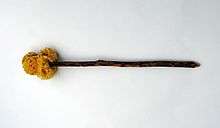Xylospongium
The xylospongium or tersorium, also known as sponge on a stick, was a hygienic utensil used by ancient Romans to wipe their anus after defecating,[1] consisting of a wooden stick (Greek: ξύλον, xylon) with a sea sponge (Greek: σπόγγος, spongos) fixed at one end.

The tersorium was shared by people using public latrines. To clean the sponge, they simply washed it in a bucket with water and salt or vinegar.[2] This became a breeding ground for bacteria, causing the spread of disease in the latrine.[3]
In classical antiquity a xylospongium might be used as a toilet brush.[4]
In the baths of the seven sages in Ostia, a fresco from the 2nd century contains the Inscription (u)taris xylosphongio[5] which is the first known mention of the term. Also in the early second century a papyrus letter of Claudius Terentianus to his father Claudius Tiberianus uses the term xylospongium in a phrase.[6]
In the middle of the first century Seneca reported that a Germanic gladiator had committed suicide with a sponge on a stick. The Germanic gladiator hid himself in the latrine of an amphitheater and pushed the wooden stick into his gullet and choked to death.[7]
See also
Citations
- Mirsky, Steve. "Getting to the Bottom". Scientific American. 308 (3): 85–85. doi:10.1038/scientificamerican0313-85.
- Nash, Stephen E. "What Did Ancient Romans Do Without Toilet Paper?". Sapiens. Retrieved 4 June 2019.
- Gigante, Linda. "Death and Disease in Ancient Rome". innominatesociety.com. Archived from the original on 21 September 2019. Retrieved 4 June 2019.
- Wiplinger 2012, S. 300-301.
- L'Année épigraphique 1941, 5.
- (Non magis quravit me pro xylesphongium ..., "He paid no more attention to me than to a sponge stick" (Michigan Papyri VIII 471 = CEL 146 = ChLA XLII 1220 29), "HGV". aquila.zaw.uni-heidelberg.de. Retrieved 2020-04-05.
- Seneca, Epistulae morales 8, 70, 20. ... lignum id, quod ad emundanda obscena adhaerente spongia positum est, totum in gulam farsit ..., "the stick with a sponge attached, that is there for wiping the unmentionables, he stuffed it as it was down his throat".
General references
Primary sources
- Claudius Terentianus, Michigan Papyri VIII 471 (inv. 5393) = CEL 146 = ChLA XLII 1220 29.
- Seneca, Epistulae morales Liber 8, 70, 20.
- Martial, Epigrammata, Liber 12,48,7.
Secondary sources
- Richard Neudecker: Die Pracht der Latrine. Zum Wandel öffentlicher Bedürfnisanstalten in der kaiserzeitlichen Stadt. Pfeil-Verlag, München 1994 (Studien zur antiken Stadt, Bd. 1) ISBN 3-923871-86-4, pp. 36f.
- Gilbert Wiplinger: "Der Gebrauch des Xylospongiums – eine neue Theorie zu den hygienischen Verhältnissen in römischen Latrinen". In: SPA . SANITAS PER AQUAM. Tagungsband des Internationalen Frontinus-Symposiums zur Technik – und Kulturgeschichte der antiken Thermen Aachen, 18. – 22. März 2009. Frontinus-Gesellschaft e.V. & Peeters, Leiden 2012. ISBN 978-90-429-2661-5. pp. 295–304.